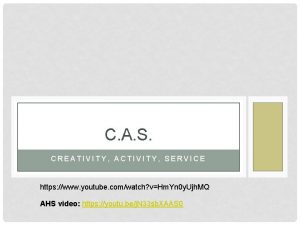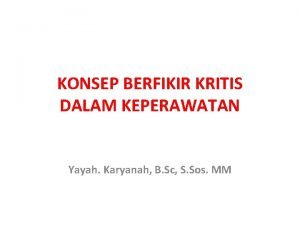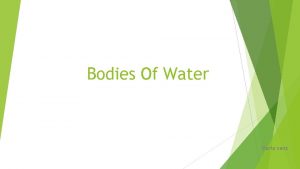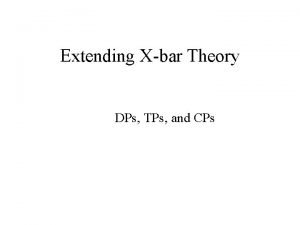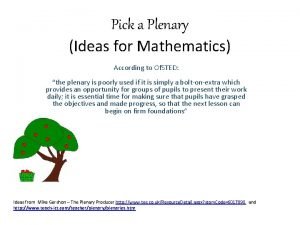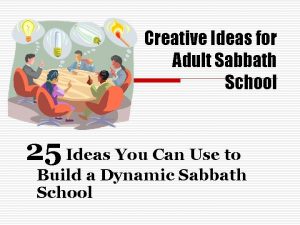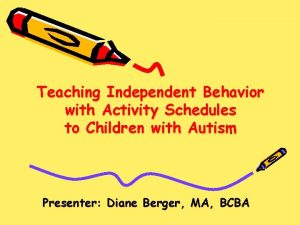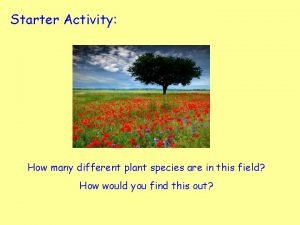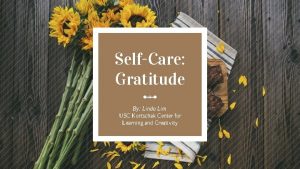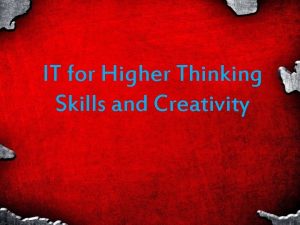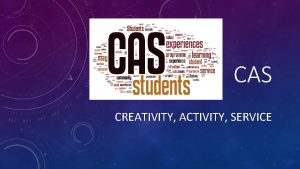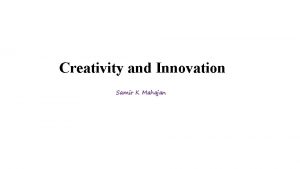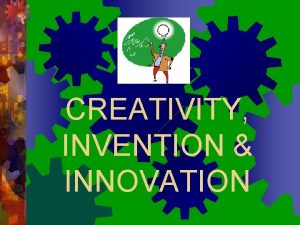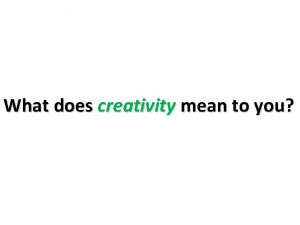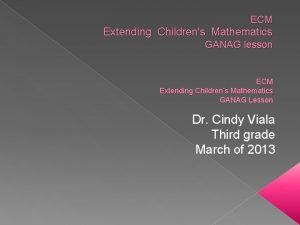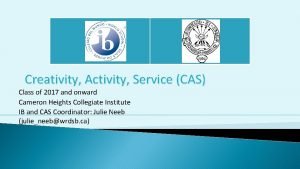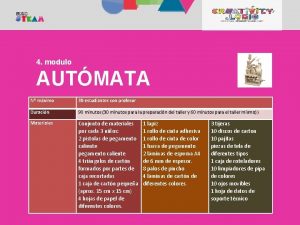Creativity Activity Service Creativity Exploring and extending ideas






























- Slides: 30

Creativity, Activity, Service

Creativity Exploring and extending ideas leading to an original or interpretive product or performance Provides students the opportunity to explore their own sense of original thinking and expression Should come from student’s talents, interests, passions, emotional responses, and imagination

Creativity may include… Visual Digital and performing arts design Writing Film Culinary Crafts Etc. arts

Demonstrating Creativity When demonstrating creative expression, students may showcase their product or performance Creativity is NOT met by the appreciation of the creative efforts of others (such as attending an art exhibit)

Reflection Students should have meaningful reflection on each creativity experience Creativity may provide inspiration for the ways in which a student reflects For example, students may reflect through: Art Music A brief narrative A blog posting Photos A skit Etc.

Approaches to Creativity Ongoing A Creativity student may already be engaged in creativity as part of a school group or club, or through some other form of sustained creativity. Students may continue in this as part of their creativity; however, students should also further extend and develop their participation.

Approaches to Creativity (continued) School-based Students creativity are encouraged to participate in meaningful creativity and to explore their own sense of original thinking and expression. In school, there may well be appropriate creativity opportunities in which the students can engage. These creativity experiences could be part of a service project, a school club, etc.

Approaches to Creativity (continued) Community-based Participating creativity in creativity within the local community advances student awareness and understanding of interpersonal relationships with others, particularly if the creativity experience involves the local community. Creativity experiences best occur with a regularity that builds and sustains relationships while allowing the growth of students’ talents, interests, passions, emotional responses, and imagination. For example, students could join a community-based theatre group, contribute towards a community art gallery, or create a sculpture for the community park.

Approaches to Creativity (continued) Individual Students creativity may decide that they wish to engage in solitary creativity experiences such as composing music, developing a website, writing a compilation of short fiction stories, designing furniture, creating arts and crafts, or painting portraits. Such creativity experiences are of most benefit when they take place over an extended duration of time. Students should set personal goals and work towards these in a sustained manner. Risk assessment of such solitary creativity experiences should be conducted with the student beforehand if applicable.

Activity Physical exertion contributing to a healthy lifestyle The aim is to promote lifelong healthy habits related to physical well-being Students are encouraged to participate at an appropriate level and on a regular basis to provide a genuine challenge and benefit

Activity can include… Individual Team sports Aerobic exercise Dance Outdoor Fitness Etc. recreation training

Approaches to Activity Ongoing A activity student may already be engaged in activity as part of a school team or club, or through some form of sustained physical exercise. Students may continue in this as part of their activity; however, they should set personal goals in keeping with the principles of CAS. Students are also encouraged to further extend and develop their participation.

Approaches to Activity (continued) School-based Students activity are encouraged to participate in meaningful activity that benefits their physical well-being. In school there may well be appropriate activity opportunities in which the student can engage. These activity experiences could, for example, be part of the school curriculums, a school sports club, or timetabled sports sessions. Students may elect to initiate a school-based activity such as basketball or tennis and engage other CAS students or any student within the school.

Approaches to Activity (continued) Community-based Participating activity in activity within the local community advances student awareness and understanding of interpersonal relationships. However, single events of activity can lack depth and meaning. When possible, activity experiences best occur with a regularity that builds and sustains relationships while allowing the growth of physical well-being for students. For example, instead of a single experience fun run, students could be encouraged to join a community-based running club.

Approaches to Activity (continued) Individual activity Students may decide that they wish to engage in solitary activity experiences such as attending a gym, bicycling, roller-skating, swimming, or strength conditioning. Such activity experiences are of most benefit when they take place over an extended duration of time. Students can be encouraged to set personal goals and work towards these in a sustained and correctly applied matter. Risk assessment of such solitary activity experiences should be conducted with the student beforehand if applicable.

Service Collaborative and reciprocal engagement with the community in response to an authentic need The aim of “Service” is for students to understand their capacity to make a meaningful contribution to their community and society. Students develop and apply personal and social skills in real-life situations involving: Decision-making Problem-solving Taking initiative Responsibility and accountability for their actions

Service Learning The development and application of knowledge and skills towards meeting an identified community need Builds upon students’ prior knowledge and background, enabling them to make links between their academic disciplines and their service experiences

Service Learning (continued) Using the CAS stages (investigation, preparation, action, reflection, demonstration) is the recommended approach for students engaging in service experiences. As students progress through each of these stages, they can draw upon the skills and knowledge gained from their academic subjects to support their experiences.

Four Types of Service Action Direct service Student interaction involves people, the environment, or animals. For example: One-on-one Developing Working tutoring a garden in partnership with refugees at an animal shelter

Four Types of Service Action (continued) Indirect service Though students do not see the recipients of indirect service, they have verified their actions will benefit the community or environment. For example Re-designing Writing a non-profit organization’s website original picture books to teach a language Nurturing seedlings for planting

Four Types of Service Action (continued) Advocacy: Students speak on behalf of a cause or concern to promote action on an issue of public interest. For example Initiating an awareness campaign on hunger Performing Creating a play on replacing bullying with respect a video on sustainable water solutions

Four Types of Service Action (continued) Research Students collect information through varied sources, analyze data, and report on a topic of importance to influence policy or practice. For example Conduct environmental surveys to influence their school Contribute Compile Conduct to a study of animal migration effective means to reduce litter in public spaces social research by interviewing people on topics such as homelessness, unemployment or isolation

Approaches to service Ongoing When service investigating a need that leads to a plan of action implemented over time, students develop perseverance and commitment. They observe how their ideas and actions build on the contributions of others to effect change.

Approaches to service (continued) School-based While service students are encouraged to participate in meaningful service that benefits the community outside school, there may be appropriate service opportunities within the school setting. In all cases an authentic need must be verified that will be met through student action. Service needs met at school may prepare students for further action within the larger community.

Approaches to service (continued) Community-based Participating service in service within the local community advances student awareness and understanding of social issues and solutions. When possible, interactions involving people in a service context best occur with a regularity that builds and sustains relationships for the mutual benefit of all.

Approaches to service (continued) Immediate In need service response to a disaster, students often want to move towards immediate action. Typically they quickly attempt to assess the need and devise a planned response. Later, students should investigate the issue to better understand the underlying causes. With increased knowledge, students may commit to ongoing assistance.

Approaches to service (continued) International Students service are encouraged to participated locally in service before considering service opportunities outside their country. When direct communication with an overseas community is not possible, students could cooperated with an outside agency to provide an appropriated service.

Approaches to service (continued) Volunteerism Students often volunteer in service experiences organized by other students, the school, or an external group. In such cases, students benefit from prior knowledge of the context and the service needed. Being informed and prepared increases the likelihood that the students’ contribution will have personal meaning and value.

Approaches to service (continued) Service arising from the curriculum Teachers plan units with service learning opportunities in mind, students may or may not respond act. For example, while studying freshwater ecology in environmental systems and society, students decide to monitor and improve a local water system.

Source Information provided in this presentation was retrieved from the Creativity, Activity, Service Guide for students graduating in 2017 and after. Published March 2015 by International Baccalaureate Organization
 Creativity and play fostering creativity
Creativity and play fostering creativity Cas description example
Cas description example Fungsi atau manfaat berpikir kritis dalam keperawatan
Fungsi atau manfaat berpikir kritis dalam keperawatan Chapter 12 extending surface area and volume
Chapter 12 extending surface area and volume Extending x-bar theory to functional categories
Extending x-bar theory to functional categories Emerging proficient extending
Emerging proficient extending Extending oblivious transfers efficiently
Extending oblivious transfers efficiently Extending mendelian genetics
Extending mendelian genetics Double bond extending conjugation
Double bond extending conjugation Uv spectra of dienes
Uv spectra of dienes Holandric genes
Holandric genes Section 1 chromosomes and phenotype study guide a
Section 1 chromosomes and phenotype study guide a A high point of land extending into water
A high point of land extending into water Problem 8-3 extending amounts across the work sheet
Problem 8-3 extending amounts across the work sheet Large land mass
Large land mass Extending x-bar theory to functional categories
Extending x-bar theory to functional categories Identify the landform
Identify the landform Dps tps
Dps tps Parallelogram desk
Parallelogram desk Blood type dominant recessive
Blood type dominant recessive Chapter 7 extending mendelian genetics vocabulary practice
Chapter 7 extending mendelian genetics vocabulary practice Ideas have consequences bad ideas have victims
Ideas have consequences bad ideas have victims Ideas secundarias
Ideas secundarias Activity corrections
Activity corrections Plenary pyramid
Plenary pyramid 25 creative ideas for sabbath school
25 creative ideas for sabbath school Independent activity schedule ideas
Independent activity schedule ideas Paired statement keys
Paired statement keys How to overcome barriers to creativity and innovation
How to overcome barriers to creativity and innovation Usc kortschak center for learning and creativity
Usc kortschak center for learning and creativity It for higher thinking skills and creativity
It for higher thinking skills and creativity

